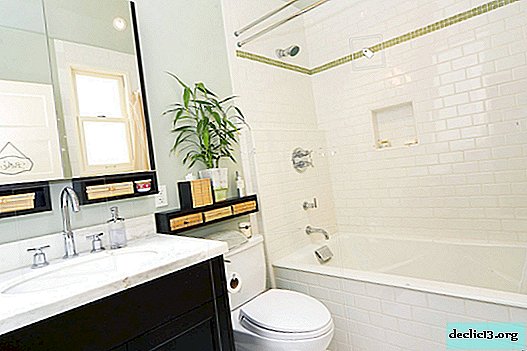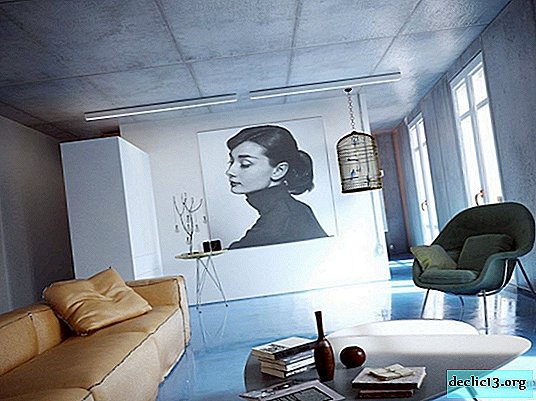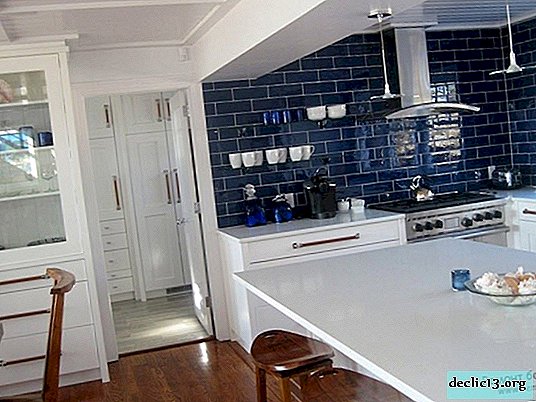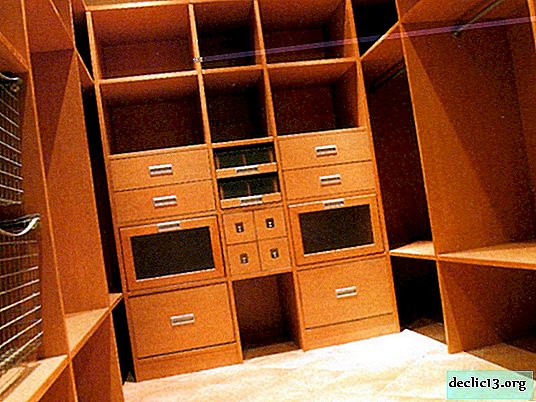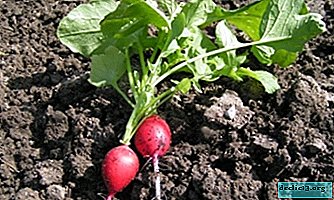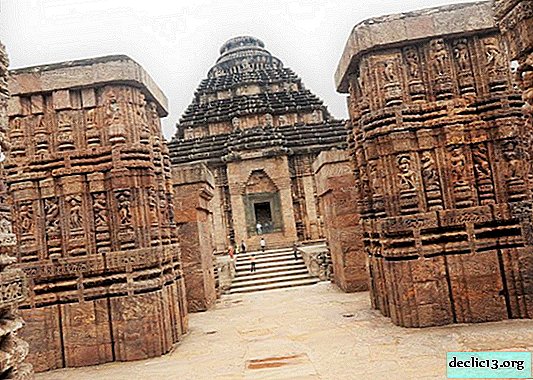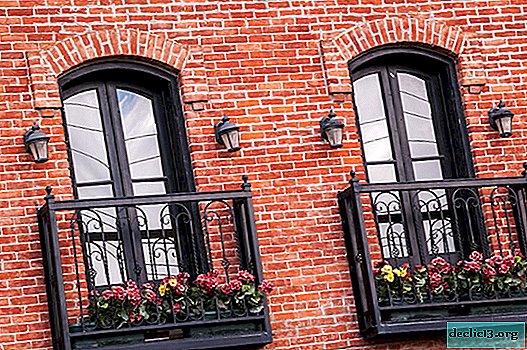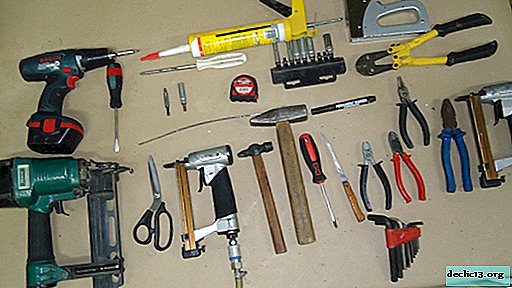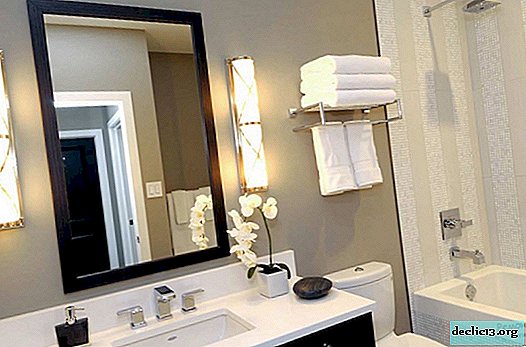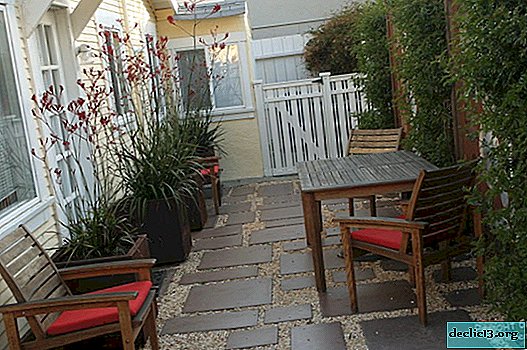The Little Healer - Kamchatsky Rhododendron: flower photo
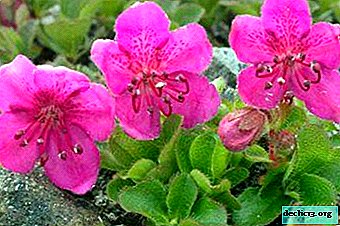
Garden rhododendron is represented by more than three thousand varieties, varieties and forms. There are quite miniature varieties, there are creeping ones, and there are quite high types.
The color of the flowers and the shape of the leaves are also different, but all varieties combine similar living conditions. And they are loved for their unrealistically beautiful flowering, which can be quite long.
From the article you will learn more about this flower, see its photo, get acquainted with the rules of care and reproduction.
View description
Kamchatsky Rhododendron is a very small (miniature) perennial shrub, which mainly grows in the Khabarovsk region, but it can also be found on Chukotka and on the shores of the Sea of Okhotsk.
Reference! It belongs to deciduous frost-resistant varieties.This type of rhododendron is able to grow in height by a maximum of 20 - 30 cm, it is called dwarf. Outwardly, it looks like a small beautiful pillow. Kamchatsky rhododendron blooms in summer, likes to grow on open wet slopes.
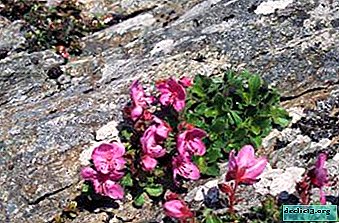 Flowers - large, bright raspberry color, can be pale violet in a small speck, do not have aroma. Each inflorescence consists of 3 flowers. Petals have a pleasant velvety surface.
Flowers - large, bright raspberry color, can be pale violet in a small speck, do not have aroma. Each inflorescence consists of 3 flowers. Petals have a pleasant velvety surface.- Leaves - juicy bright green color, ovoid in shape, large enough, reach 5 cm in length.
- Trunk - the bark is dark gray, the shape of the bush is creeping, the branches are brown in color, gracefully curved.
- Fruit - yellow seed capsules ripen in August.
- Roots - superficial, thin.
History of occurrence
Biologists say that the first rhododendrons appeared in nature many millions of years ago, but they began to be cultivated in household plots only in the 19th century, and they spread very slowly. Probably because this beautiful shrub in the care is quite capricious and you need to tinker with it a lot in order to succeed.
Healing properties
Flowers and leaves of this species have excellent healing properties., they can help with diseases of the nervous system, cardiovascular, colds, with joint and headaches. And drugs, which include extracts from rhododendron, effectively relieve pain and temperature, disinfect and soothe.
What is the difference from the rest?
Rhododendron Kamchatsky differs from other species in its small size, and also the branches and processes of it have not a smooth, but a rough surface, they are rough to the touch. The main difference is that his flowers bloom from buds, which are hidden in the depths of twigs, and not from buds planted in autumn, as in other species.
Subcort
The sub-varieties of this variety of rhododendron differ only in the color of the flowers., they can be bright crimson, red, purple, pink and white.
Photo
Next, you can familiarize yourself with visual photos of different colors of this type:





Bloom
The flowering period begins in June and can continue until the fall. Flowers are shaped like bells, rather large, formed at the ends of branches, usually 2 or 3 pieces. Color varies from bright crimson to white.
- Care before and after flowering - so that the bush pleased with its flowering, you must not forget to water and spray it, creating the desired humidity. After flowering, of course, continue the same care, but still do not forget to remove the peduncles with faded flowers.
- What to do if it does not bloom - perhaps the plant does not have enough moisture, or they picked up the wrong place for it, maybe it’s worth replanting the bush and clearly adjusting the watering regime.
Use in garden design
Rhododendron Kamchatsky is perfect for creating various borders in the garden, alpine hills. It is also used for planting in any pattern to indicate the natural boundaries of the site.
Advice! Interestingly, such a rhododendron looks among the stones.Step-by-step care instructions
- Choosing a landing place - the place can be open or partial shade, it is better if this partial shade is from a pine or fir, it is very good to place this creeping shrub on a slope, it will feel great there and look great.
- Which should be the soil - the soil is loose and drained, it should be slightly acidic, not very fertile, better rocky.
- Landing - you need to plant a bush in early spring, first dig a hole where peat with humus (equally) is introduced, then drainage is poured, then only you can lower the seedling there. Carefully fall asleep and make sure that the root neck does not fall asleep. Then you need to make a near-stem well and water it well, preferably with river or rain water.
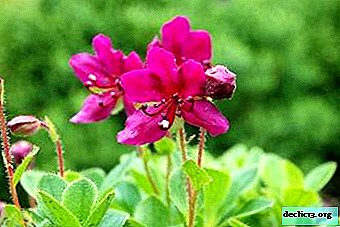 Temperature - the plant is frost-resistant, able to withstand 28 degrees of frost, does not like the heat very much, but it can withstand a maximum temperature of 30 degrees, the optimum temperature will be from 10 degrees of frost to 15 degrees of heat.
Temperature - the plant is frost-resistant, able to withstand 28 degrees of frost, does not like the heat very much, but it can withstand a maximum temperature of 30 degrees, the optimum temperature will be from 10 degrees of frost to 15 degrees of heat.- Watering - air humidity is required high, it is necessary to spray the plant (especially in hot weather), it is also good to use sprinkling. It is necessary to water deeply about once a week, and in the heat more often - 2 times a week.
- Top dressing - in the spring you can make compost (well-rotted). The special liquid fertilizer “For Rhododendrons” young bushes need to be fed 2 times per season: in early spring and autumn after flowering, and adults only once in spring.
- Pruning - Forming pruning is not required, it will be enough at the end of flowering to remove peduncles and cut broken or diseased branches.
- Transfer - Persadok is inadmissible in the fall or during the flowering of the bush, the optimal time is early spring.
Propagation Features
Kamchatka rhododendron can be propagated by dividing the bush, cuttings or seeds.
The cuttings root easily, in the spring they need to be cut 10 cm long, lowered into a light substrate (pre-dip into the stimulator) and after about a month they can be peaked, the roots will already be formed. By landing at a permanent place, the cuttings will be ready for next spring.
Features of seed reproduction - this method of reproduction is characteristic of Kamchatka Rhododendron, it gives excellent results. You just need to do everything right: you don’t need to process the seeds, sow them in the soil in December or January - just sprinkle them on the surface. To create greenhouse conditions, the humidity should be high and the temperature should not be lower than 20 degrees. Germination is 90% and higher, this is a very high indicator. In the third year, these seedlings will already bloom.
Diseases and Pests
Most often, rhododendron suffers from fungal diseases. Usually this happens because the soil where the shrub has been planted is completely unsuitable for it - it is too dense and heavy. Therefore, the roots begin to suffer, normal development is impaired, and as a result, the bush urgently needs treatment. It can be treated with Bordeaux liquid, and then transplanted to a more suitable place.
Important! The most characteristic pests for this plant are a spider mite and a rhododendron bug, treatment with an insecticide will save these uninvited "guests".Prevention of various problems
Firstly, the best prevention is careful proper care. You can also treat bushes for prevention with Bordeaux liquid in spring and a weak solution of Tiram fungicide.
Conclusion
It’s not so often that you can meet with us Kamchatsky rhododendron in garden plots, well, if only in the Moscow region or in Kamchatka. However, those who took a chance and tried to plant this wonderful little bush - a pillow, would never give up on it. If you try hard, then any site can be used to turn it into a work of art.

 Flowers - large, bright raspberry color, can be pale violet in a small speck, do not have aroma. Each inflorescence consists of 3 flowers. Petals have a pleasant velvety surface.
Flowers - large, bright raspberry color, can be pale violet in a small speck, do not have aroma. Each inflorescence consists of 3 flowers. Petals have a pleasant velvety surface. Temperature - the plant is frost-resistant, able to withstand 28 degrees of frost, does not like the heat very much, but it can withstand a maximum temperature of 30 degrees, the optimum temperature will be from 10 degrees of frost to 15 degrees of heat.
Temperature - the plant is frost-resistant, able to withstand 28 degrees of frost, does not like the heat very much, but it can withstand a maximum temperature of 30 degrees, the optimum temperature will be from 10 degrees of frost to 15 degrees of heat.
